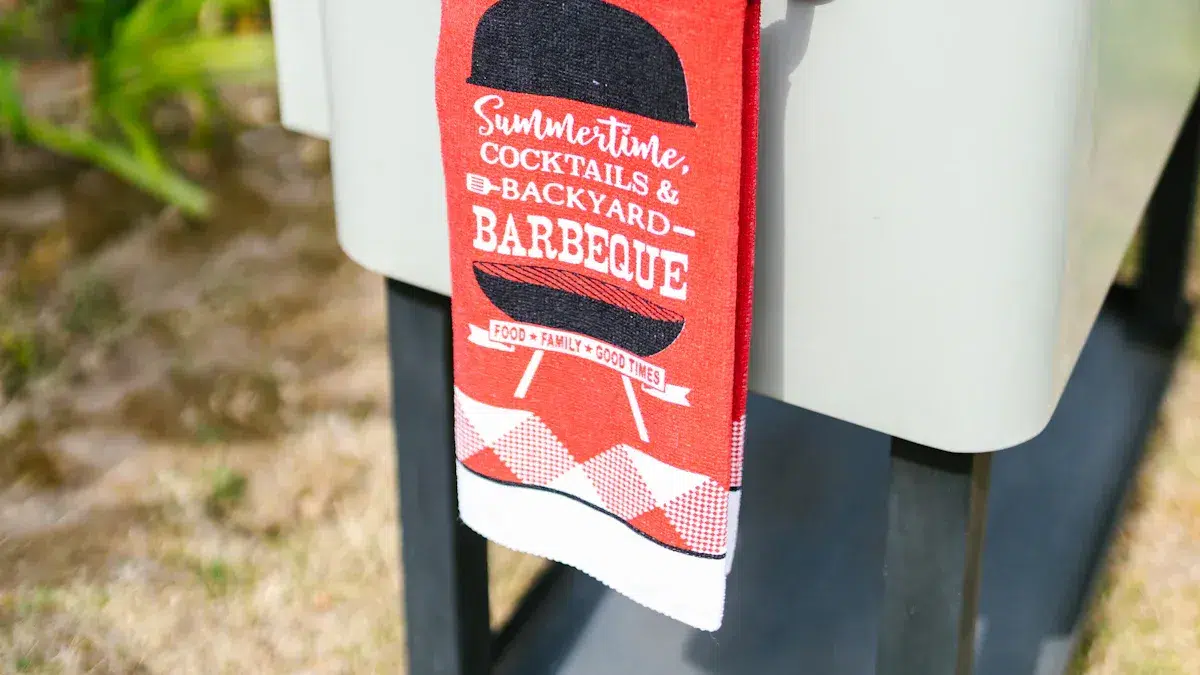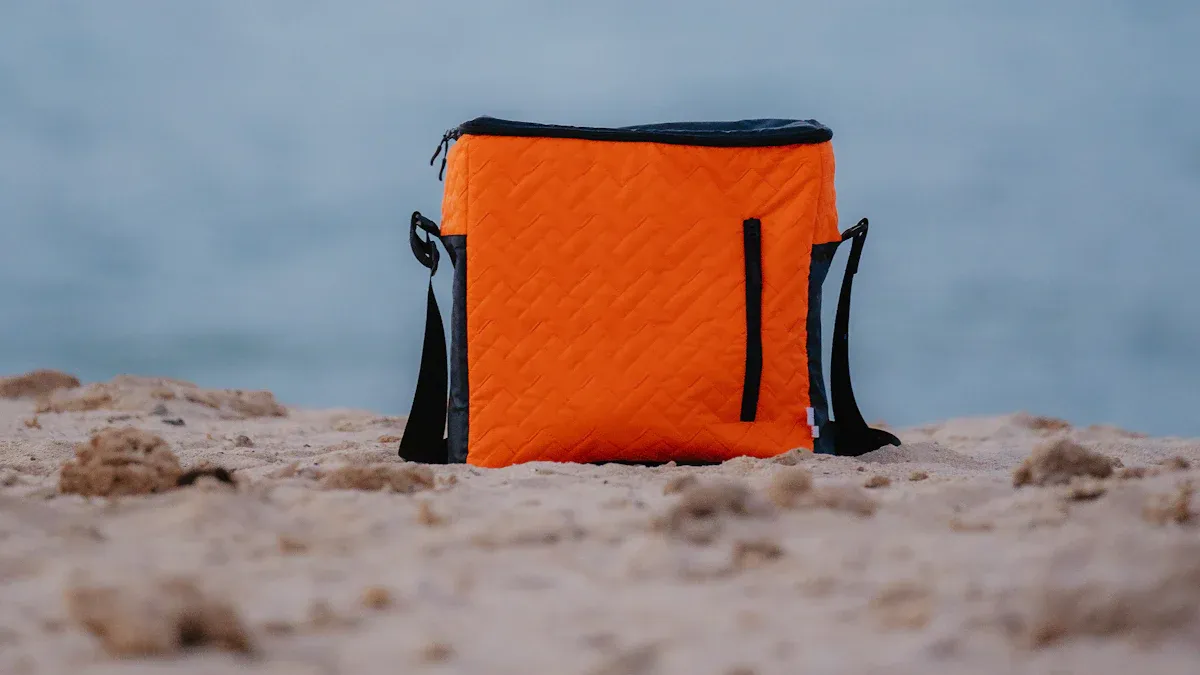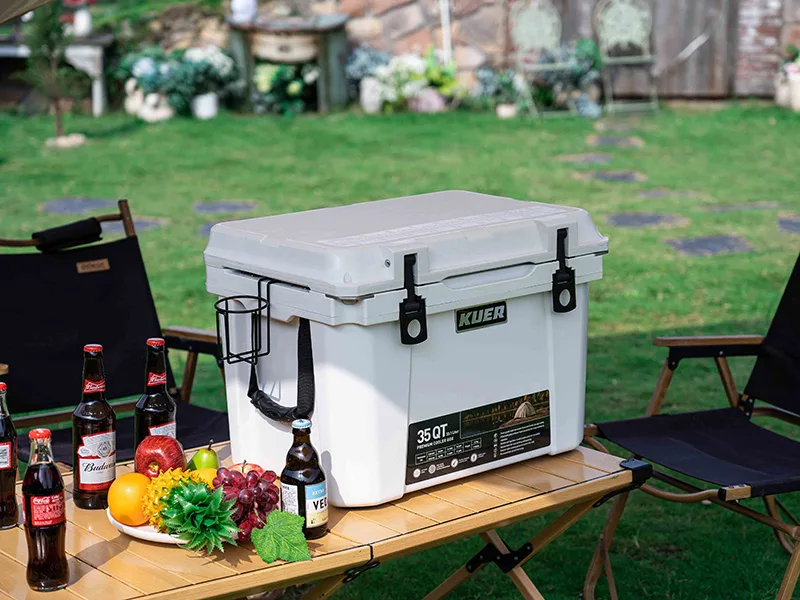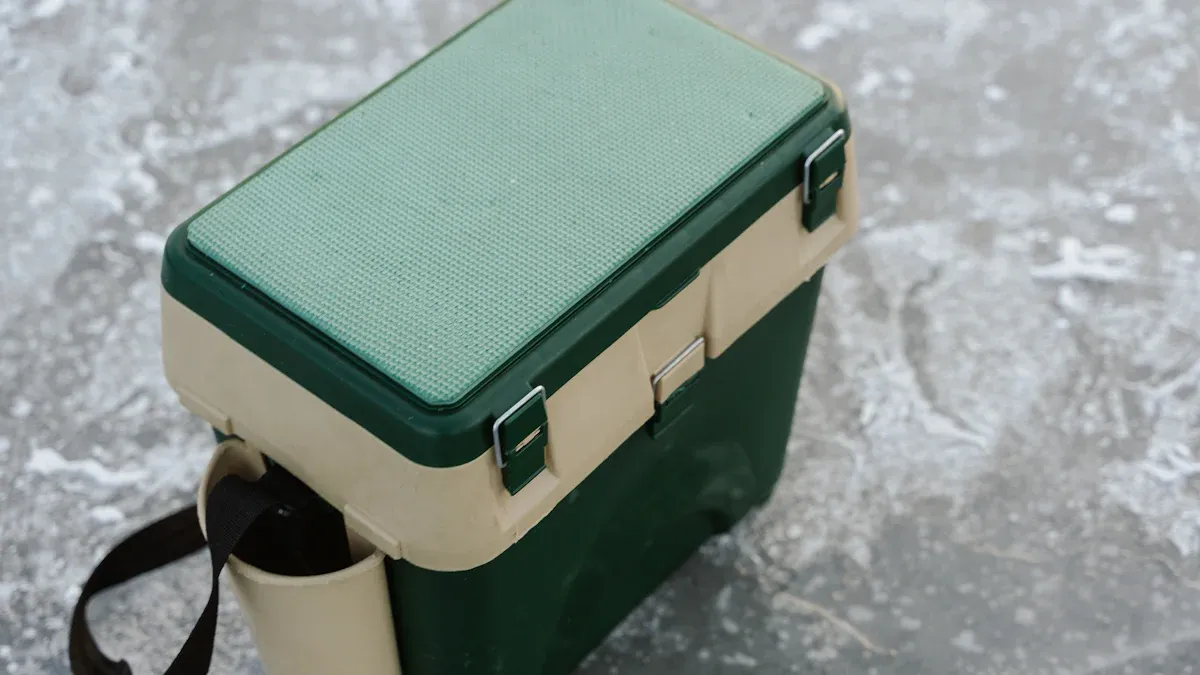
Imagine you plan a camping weekend with friends or a large family BBQ. You need to choose a cooler that fits your food, drinks, and ice, but not all coolers work for every trip. Choosing the right cooler depends on trip length, group size, and storage needs. If you pick a huge cooler box with the right features, you keep food fresh and drinks cold for your entire outdoor adventure. The table below shows how matching cooler size and features to your outdoor plans helps you succeed and enjoy your trip:
| Cooler Box Size (Capacity) | Typical Use Case / Outdoor Activity | Impact on User Satisfaction / Trip Success |
|---|---|---|
| Below 25 quarts | Personal or small group use; high portability | High convenience and ease of transport; suitable for short trips, enhancing user satisfaction through portability |
| 25 – 50 quarts | Families and outdoor enthusiasts; balanced capacity and portability | Supports moderate group size trips; balances storage and transport, improving trip success by adequate storage |
| 51 – 100 quarts | Larger groups or extended trips | Ensures sufficient storage and thermal retention for longer durations, critical for trip success and food freshness |
| Above 100 quarts | Heavy-duty or commercial use; large group outings | Maximum storage capacity; supports extensive trips or commercial needs, enhancing reliability and user satisfaction |
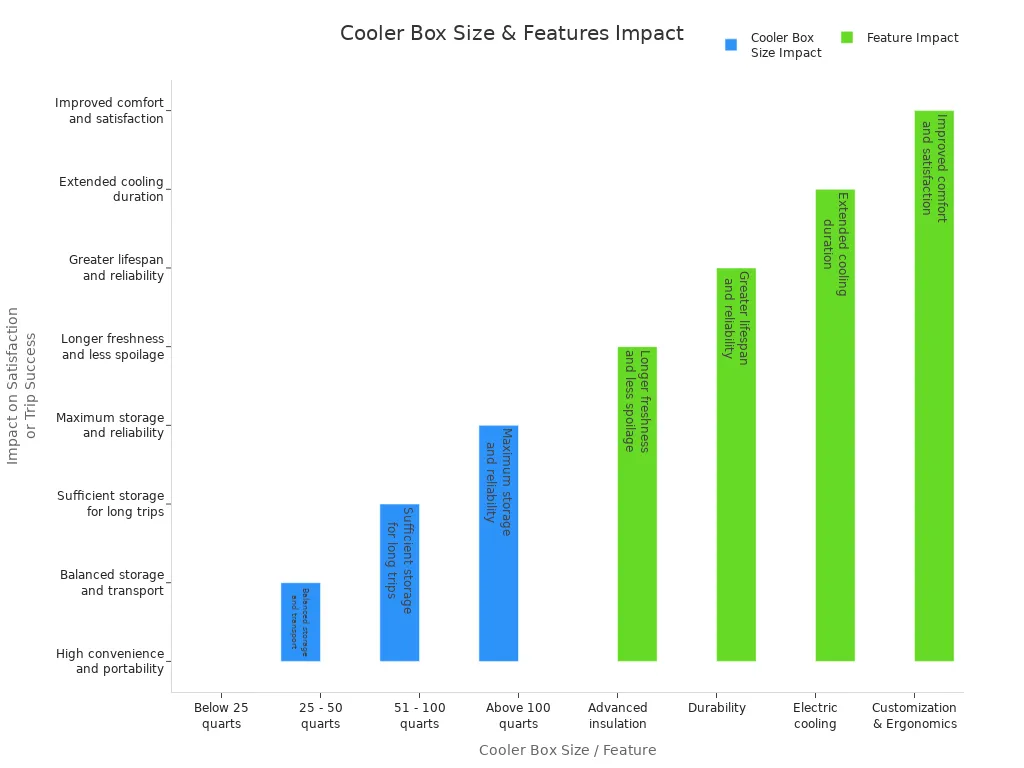
Why Size Matters
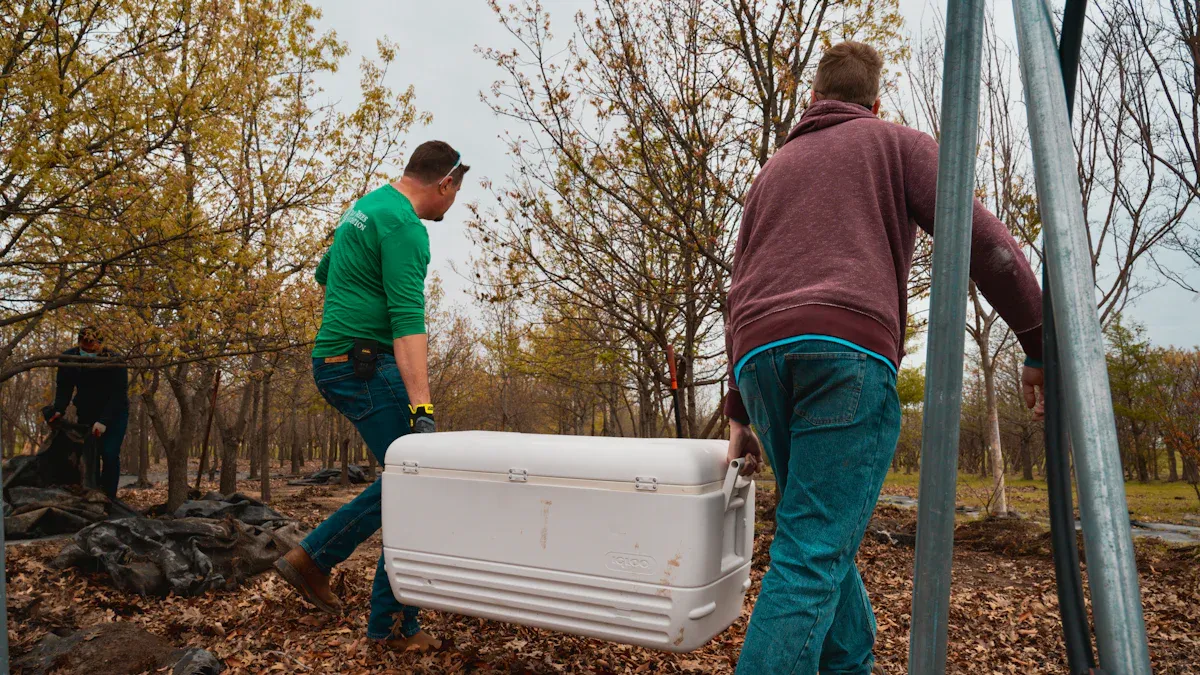
Huge Cooler Box Capacity
When you plan an outdoor adventure, the right cooler size and capacity make a big difference. If you choose a cooler that is too small, you run out of space for food and drinks. If you pick a huge cooler box, you can store enough supplies for everyone. Cooler sizes range from small personal models to massive coolers for large groups. For big gatherings or long trips, you need a cooler with a large capacity and strong insulation.
Cooler capacity is measured in quarts. Most huge cooler boxes for group outings hold between 45 and 110 quarts. These coolers keep ice for several days and protect your food from heat. The table below shows popular cooler sizes, their capacity, and special features:
| Cooler Model | Capacity (quarts) | Ice Retention (days) | Notable Features |
|---|---|---|---|
| Rovr RollR | 60 | ~1.3 (32 hours) | Spacious, sturdy wheels, grippy pull handle |
| Canyon Coolers Pro | 45 | >2 (48+ hours) | Section divider, cutting board |
| Coleman Pro Ultra-Light | 45 | >2 (48+ hours) | Lightest, ideal for beach trips |
| Yeti Tundra Haul | 50 | ~1 (24+ hours) | Durable, bear lock compatible |
| Titan Pro | 55 | ~5 | Holds ~80 cans, easy latches, internal light |
| KUER | 110 | Multiple days | Large capacity, strong insulation, durable |
Tip: Always check the cooler capacity before your trip. A huge cooler box with more space means fewer worries about running out of cold drinks or fresh food.
Group Size & Trip Length
Cooler sizes matter most when you travel with a group or stay outdoors for several days. If you camp with family or friends, you need a size camping cooler that fits everyone’s needs. For a weekend trip, a 45- to 60-quart cooler often works well. For longer adventures or bigger groups, you should choose a cooler with a capacity of 100 quarts or more.
The chart below shows how cooler sizes match different group sizes and trip lengths:
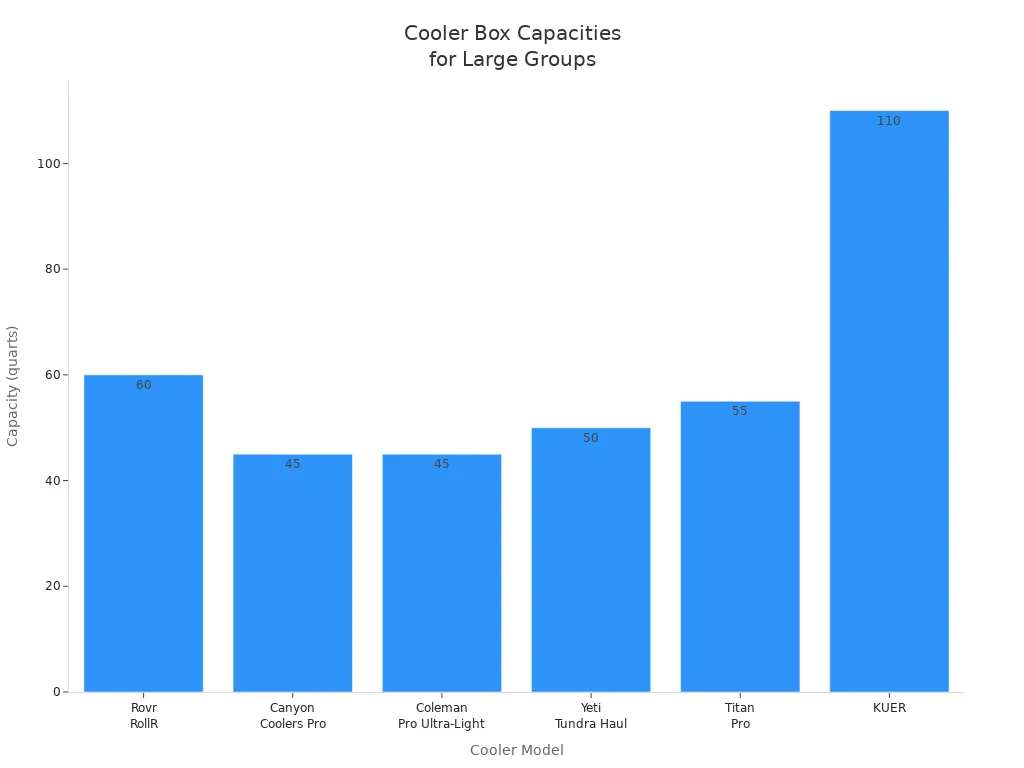
When you choose a cooler, think about how many people join you and how long you will stay. The right cooler size and capacity help you keep food safe and drinks cold, making your adventure more enjoyable.
Cooler Types
Hard Cooler vs. Soft Cooler
When you choose a cooler for your outdoor adventure, you need to decide between a hard cooler and a soft-sided cooler. Each type offers unique benefits for different situations. A hard-sided cooler gives you maximum durability and long-lasting ice retention. You can use a hard cooler for rough trips, long camping weekends, or fishing expeditions. Many hard coolers, like the Yeti Tundra or OtterBox Venture, use thick walls and sturdy latches. These features help the hard cooler keep ice for up to 10-12 days. Some hard coolers even have bear-proof designs and modular accessories.
A soft-sided cooler works best when you want something light and easy to carry. You can take a soft-sided cooler on a short hike, a picnic, or a quick day trip. Most soft-sided coolers use flexible materials and backpack straps. This makes the soft-sided cooler easy to transport. However, a soft-sided cooler usually keeps ice for only 1-2 days. You should use a soft-sided cooler for smaller loads and shorter outings.
Here is a table that compares the key features of each cooler type:
| Cooler Type | Key Features | Ice Retention | Weight & Portability | Typical Use Cases |
|---|---|---|---|---|
| Hard Coolers (e.g., OtterBox Venture, RovR RollR 60, Pelican Elite, Yeti Tundra) | Rotomolded, very durable, bear-proof, modular accessories, heavy-duty construction | Excellent, up to 10-12 days (e.g., Yeti Tundra 12 days, OtterBox Venture nearly 2 weeks) | Heavy (e.g., RovR RollR 45 lbs), often bulky, some with wheels or handles for easier transport | Extended trips, rough outdoor use, heavy loads, long ice retention needed |
| Soft Coolers (e.g., Hydro Flask Unbound, Pelican SC24, Yeti Hopper BackFlip, OtterBox Trooper) | Softer materials, lighter, more portable, backpack-compatible, fewer accessories | Lower, generally 1-2 days (e.g., Hydro Flask Unbound nearly 2 days, Pelican SC24 less than 1 day) | Lighter weight but some models still heavy (Pelican SC24 5 lbs), designed for carry-ability, some backpack straps | Shorter outings, smaller loads (e.g., 20-30 cans), prioritize portability over max insulation |
Tip: If you plan a long trip or need to keep food cold for several days, pick a hard cooler. For a quick outing or when you need to travel light, a soft-sided cooler is your best choice.
Rotomolded vs. Blow-Molded
You also need to consider how your hard-sided cooler is made. The two main types are rotomolded and blow-molded. Rotomolded coolers use a process where heated polyethylene rotates inside a mold. This creates a seamless, thick shell. A rotomolded hard cooler is almost indestructible. You can drop it, bump it, or leave it in the sun. The thick walls and even foam insulation help the hard cooler keep ice for up to 11 days. Many rotomolded hard-sided coolers come with replaceable parts and long warranties.
Blow-molded coolers use a different method. Polypropylene plastic stretches thinly across a mold. This makes the hard-sided cooler lighter and less expensive. However, the shell is thinner, and the corners can crack more easily. The insulation is not as thick, so the hard cooler does not keep ice as long. Blow-molded hard coolers work well for short trips or when you want to save money.
Here is a table that shows the differences between rotomolded and blow-molded hard-sided coolers:
| Feature | Roto-Molded Coolers | Blow-Molded Coolers |
|---|---|---|
| Manufacturing Method | Heated polyethylene rotated inside mold to form a seamless shell | Polypropylene plastic blow-molded, stretched thinly across mold |
| Shell Durability | Practically indestructible, seamless, thick shell | Thinner plastic, weaker corners prone to cracking |
| Insulation Material | Thick (2 inches) high-density polyurethane foam injected evenly around all walls, floor, corners, and lid | Hollow lids made from single piece of plastic, less effective insulation |
| Ice Retention | Tested to hold ice for up to 11 days | Less effective ice retention |
| Temperature Resistance | Polyurethane withstands extreme temperatures | Higher melting temperature but less durable overall |
| Longevity & Warranty | Designed to last, replaceable parts, warranty covers defects | Generally cheaper but less durable, frequent replacements needed |
Note: If you want the best performance and durability, choose a rotomolded hard cooler. For lighter use or lower cost, a blow-molded hard-sided cooler can still serve you well.
Electric & Specialty Coolers
Some outdoor adventures need more than a regular hard cooler or soft-sided cooler. Electric coolers use power from your car or a portable battery. You can set the temperature and keep food cold or even frozen. This type of cooler works well for road trips, RV camping, or long fishing trips. Electric coolers do not need ice, so you get more space for food and drinks.
Specialty coolers include models with built-in lights, cup holders, or even Bluetooth speakers. Some hard coolers have wheels and handles for easy transport. You can also find hard-sided coolers with extra-thick insulation for extreme heat. These specialty coolers help you match your cooler to your activity and make your trip more comfortable.
Callout: Always check if your adventure needs a special feature. The right hard cooler or soft-sided cooler can make your trip easier and more fun.
Large Coolers: Key Features
Ice Retention & Insulation
When you choose a hard cooler for your outdoor adventure, ice retention becomes one of the most important features. Large coolers with thick insulation can keep ice for several days, which helps you keep food fresh and drinks cold. Most standard hard coolers hold ice for about two days under typical outdoor conditions. If you pick a higher-end hard cooler, you can expect ice retention for four to four and a half days. Some coolers keep ice the longest because they use advanced insulation and tight seals.
You should look for a cooler with thick walls and lids. These features stop warm air from getting in and cold air from escaping. Many top coolers use special insulation materials inside the walls. Polyurethane foam is the most common insulation in high-quality hard coolers. This material gives excellent thermal resistance and helps coolers keep ice the longest. Some brands add extra insulation layers or use gel-based or vacuum insulation for even better performance.
A cooler with thick insulation and a tight gasket seal around the lid will slow down ice melt. This means you can enjoy cold drinks and safe food for your entire trip. If you plan a long adventure or travel in hot weather, always check the insulation and ice retention rating before you buy.
Tip: For the best results, pre-chill your cooler and use large ice blocks. This helps maximize ice retention and keeps your supplies cold longer.
Durability & Build Quality
Durability matters when you use a hard cooler outdoors. You want a cooler that can handle bumps, drops, and rough handling. Rotomolded construction gives you the strongest and most reliable hard coolers. This method creates a single-piece, seamless shell with thick walls and no weak points. Rotomolded coolers resist cracks, dents, and impacts, so they last for years even in tough conditions.
KUER uses rotomolded construction and high-density polyethylene (HDPE) for the outer shell. HDPE stands up to rough use, UV rays, and harsh weather. Polyurethane foam inside the cooler adds strength and improves insulation. Quality control at KUER ensures every cooler meets strict standards for performance and durability.
You can compare rotomolded and injection-molded coolers in the table below:
| Construction Method | Durability Impact | Lifespan Impact |
|---|---|---|
| Rotomolding (Rotomolded) | Single-piece, seamless thick walls; very high impact resistance; excellent durability | Longer lifespan; resists cracks, dents, and impacts; withstands rough use for years |
| Injection Molding | Two shells joined with seams; lower impact resistance; good but less durable | Shorter lifespan; seams may fail; less robust under rough conditions |
Rotomolded hard coolers are trusted by outdoor enthusiasts because they keep working after years of use. You can rely on them for camping, fishing, or any adventure.
Portability & Weight
Large coolers often have high capacity, but you still need to move them easily. Portability becomes important, especially when you pack a cooler full of ice, drinks, and food. Many hard coolers come with sturdy handles, wheels, and tie-down points. These features help you transport your cooler across campsites, docks, or picnic areas.
Some coolers have heavy-duty wheels that roll smoothly over rough ground. Others use strong side handles or rope handles for easy lifting. Drainage plugs make it simple to empty melted ice without lifting the whole cooler. When you choose a cooler, check the weight when empty and when full. A large cooler with wheels and good handles gives you the best mix of capacity and portability.
Note: If you plan to move your cooler often, look for models with wheels and ergonomic handles. This makes transport much easier, even with a full load.
Seals, Latches & Security
Security features protect your cooler’s contents from wildlife and theft. A good hard cooler uses reinforced latches, tight gasket seals, and locking points. These features keep the lid closed and stop animals or people from getting inside. In bear country, you need a bear-resistant cooler with IGBC-certified locks. These coolers can withstand grizzly bear attacks for at least 60 minutes.
You can also use steel cables to lock your cooler to a tree or vehicle. Heavy-duty padlocks and stainless steel hasps add extra protection. Some coolers have tamper-resistant designs and marine-grade brackets for outdoor use. Always make sure the lid closes tightly before you leave your cooler unattended.
Callout: Secure your cooler with locks and cables to keep your food safe from animals and prevent theft during your adventure.
KUER’s large coolers include many of these security features. You get reinforced latches, tight seals, and strong locking points. Quality control ensures every cooler meets high standards for safety and performance.
Practical Features for Outdoor Use
When you pick a large cooler, look for practical features that make your trip easier:
- Wheels for easy movement over rough ground
- Strong handles for lifting and carrying
- Drainage plugs for quick cleanup
- Bear resistance for safety in the wild
A cooler with these features gives you more convenience and peace of mind. KUER’s hard coolers combine high capacity, thick insulation, and smart design to help you enjoy every outdoor adventure.
Activity Match
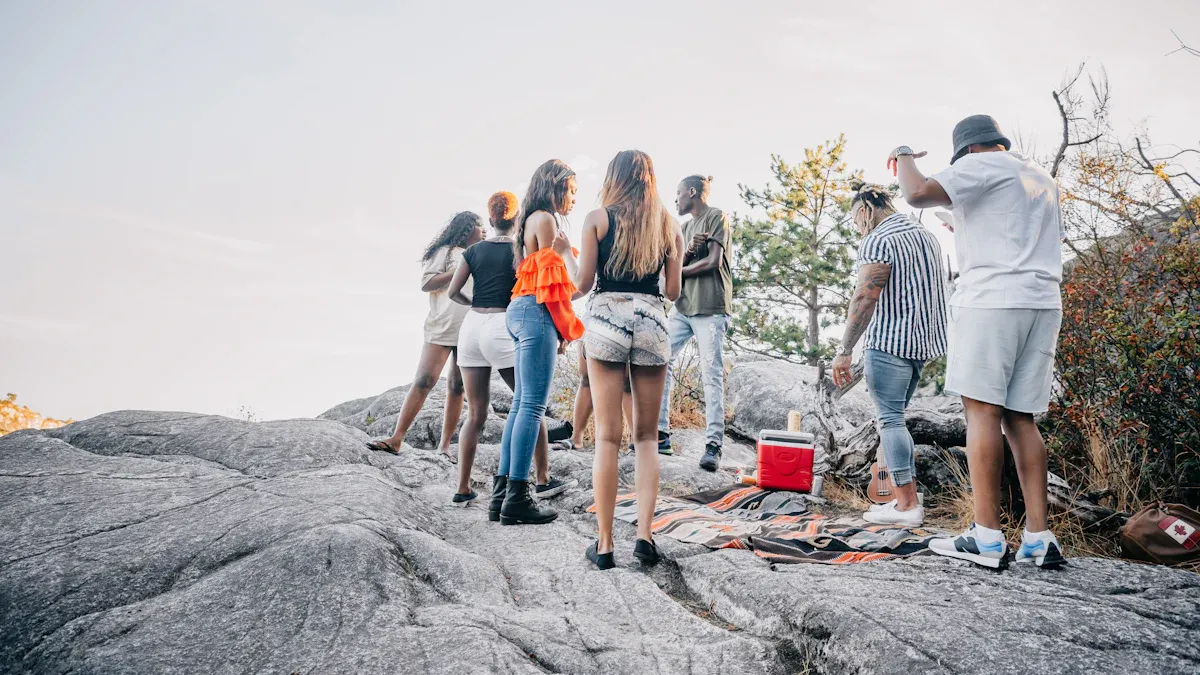
Camping Cooler Essentials
When you plan a camping trip, you need a camping cooler that fits your needs. The right camping cooler keeps your food safe and your drinks cold. You want the best cooler for camping that matches your group size and trip length. For a family camping adventure, a large camping cooler with at least 50 quarts works well. If you camp with friends for several days, you need a camping cooler with thick insulation. This helps your ice last up to five days or more.
You should look for these features in a camping cooler:
- Hard cooler construction for the longest ice retention and durability.
- Wheels and strong handles for easy movement at your camping site.
- Drainage plugs for quick cleanup after camping.
- UV resistance and waterproof seals for outdoor camping in any weather.
- Built-in cup holders and easy-access lids for convenience during camping.
A hard cooler made from high-density polyethylene stands up to rough camping conditions. Always pack a little extra food and water in your camping cooler for emergencies. The best cooler for camping helps you enjoy every moment outdoors.
Fishing & Hunting Needs
Fishing and hunting trips require a cooler that can handle tough outdoor use. You need a hard cooler that keeps your catch or game fresh for days. Choose a camping cooler with thick walls and a tight seal. This type of hard cooler holds ice longer, even in hot weather. For fishing, a camping cooler with a fish ruler on the lid and non-slip feet helps you measure and secure your catch. Hunters often use a hard cooler with bear-resistant locks for safety in the wild.
A large camping cooler with a capacity of 60 quarts or more gives you enough space for fish, game, and ice. Look for a camping cooler with easy-to-clean surfaces and drainage plugs. Portability features like wheels and rope handles make it easier to move your hard cooler from your vehicle to your outdoor spot.
Tip: Always choose a camping cooler with thick insulation and a secure lid for fishing and hunting. This keeps your supplies fresh and safe during your outdoor adventure.
BBQs & Outdoor Events
Outdoor BBQs and group events need a camping cooler that can serve many people. You want a hard cooler with enough space for drinks, snacks, and ice. For large gatherings, a camping cooler with 70 quarts or more works best. Look for a camping cooler with built-in bottle openers, cup holders, and easy-access lids. These features make your outdoor event smoother.
A hard cooler with wheels lets you move it across grass or gravel. Drainage plugs help you clean up quickly after your BBQ. Choose a camping cooler with UV protection if you spend time in the sun. Always check the insulation quality to keep your drinks cold all day.
A camping cooler with the right features makes every outdoor event more enjoyable. You can focus on fun and food, knowing your supplies stay fresh.
Handling & Maintenance
Loading & Organization
Packing your cooler the right way helps you keep food fresh and drinks cold during your camping trip. Start by using heavy-duty shopping bags or plastic containers to separate food from melting ice. This keeps your sandwiches and snacks dry and easy to find. Move liquids from glass or thin plastic bottles into sturdy screw-top containers. This step prevents spills and messes inside the cooler.
Before you leave for camping, pre-chill or freeze as much food and drink as possible. Cold items slow down ice melt and help everything stay colder longer. Freeze water bottles to use as ice packs. As they thaw, you get cold water to drink. Organize your food into separate containers for each meal. This way, you open the cooler less often and protect delicate items. Cover the cooler with a wet towel or reflective insulation to block heat from the sun. For long camping trips, bring extra coolers—one for ice, one for drinks, and one for food. This setup keeps your main cooler colder and makes it easier to find what you need.
Tip: Add foam pads or wet towels inside the cooler lid to reduce warm air exposure and keep ice from melting too fast.
Transport & Storage
Moving a large cooler can be tough, especially when it is full of ice and supplies. Use insulated containers or specialized vehicles if you need to keep items cold for a long drive. Gel packs and cold chain systems help protect your food and drinks during transport. Place temperature monitors inside the cooler to track how cold it stays.
When you store your cooler after camping, keep it in a cool, dry place. Make sure the lid stays slightly open to let air flow and prevent odors. Avoid direct sunlight and extreme heat, which can damage the cooler’s shell and insulation. Always follow best practices for packaging and handling to prevent dents or cracks.
- Use real-time temperature tracking if you carry sensitive items.
- Follow safety standards to keep your food safe and your cooler in top shape.
Cleaning Tips
Clean your cooler after every camping trip to keep it fresh and ready for next time. Take the cooler outside before cleaning. Rinse it with a garden hose to remove dirt and melted ice. Fill the cooler with warm water and a mild cleaner, then let it soak for about 10 minutes. Scrub all surfaces with a soft sponge, paying attention to corners and seals.
Mix 1/3 cup of bleach with 1 gallon of water for deep cleaning. Scrub the cooler and let the solution sit for six minutes. Rinse well with clean water. Let the cooler air dry completely before storing it. For tough stains or odors, use vinegar, lemon juice, or a baking soda paste. Store the cooler with the lid slightly open and the drain plug out to prevent mold. Check hinges, latches, and seals often. Apply food-safe silicone to moving parts to keep them working smoothly.
Note: Never drag or sit on your cooler. Overpacking can cause damage and shorten its lifespan.
Top Picks & Accessories
Recommended Huge Cooler Box Models
You want a cooler that keeps your food cold, fits your group, and matches your budget. Outdoor experts and consumers have tested many models. The table below shows top-rated choices. Each model stands out for ice retention, portability, and value.
| Cooler Model | Price | Ice Retention (hours) | Portability | Special Recognition |
|---|---|---|---|---|
| Titan Pro 55Q High Performance | $400 | 118 | Good | Best Overall; excellent insulation, waterproof, internal light, bottle opener |
| Igloo Trailmate 50 | $100 | 122 | Great | Best Value; great ice retention for price |
| Pelican 45QW Elite Wheeled | $466 | 115 | Good | Best Warranty; wheeled design |
| RTIC 45QT Ultra-Tough Wheeled | $270 | 109 | Good | Durable wheeled cooler |
| Yeti Roadie 48 | $425 | 115 | Great | Most Portable; compact size |
| Yeti Tundra 65 | $375 | 117 | Great | High ice retention and portability |
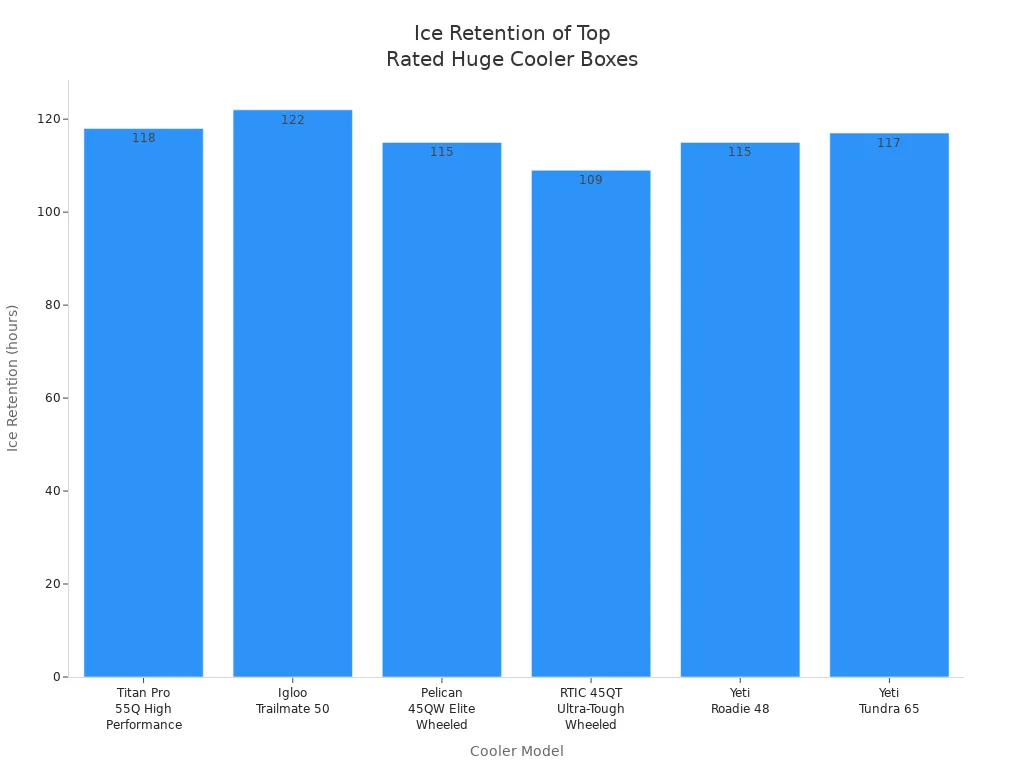
KUER’s huge cooler box models offer advanced features. You get rotomolded construction, thick foam insulation, and airtight seals. These coolers keep ice for 5 to 7 days. KUER uses over 50 patented technologies and has a large production scale. Their coolers have reinforced hinges, thick walls, and ergonomic handles or wheels. You can trust KUER for durability and performance on any adventure.
Tip: Always compare ice retention, portability, and price to find the best cooler for your needs and budget.
Must-Have Accessories
Accessories help you organize and protect your cooler’s contents. You can add baskets to keep food dry above the ice. Dividers let you separate drinks from snacks. Tie-down kits secure your cooler during transport. Cutting boards fit on top for easy meal prep. Cup holders and bottle openers add convenience at your campsite or BBQ.
Consider reusable ice packs to save space and keep items colder longer. Drain plugs make cleanup fast. For long trips, use temperature monitors to check if your food stays safe. Locks and bear-resistant latches protect your supplies in the wild.
- Popular Accessories:
- Dry baskets
- Food dividers
- Tie-down straps
- Reusable ice packs
- Drain plugs
- Cup holders
- Cutting boards
- Security locks
Note: The right accessories help you get the most from your cooler and stretch your budget. Choose items that match your trip and storage needs.
When you choose a huge cooler box, focus on these key factors for the best results:
- Size and capacity for your group and trip length
- Insulation and ice retention for food safety
- Durability and eco-friendly design
- Features that match your camping or outdoor plans
KUER’s models offer advanced rotomolded construction, strong seals, and great value compared to other brands.
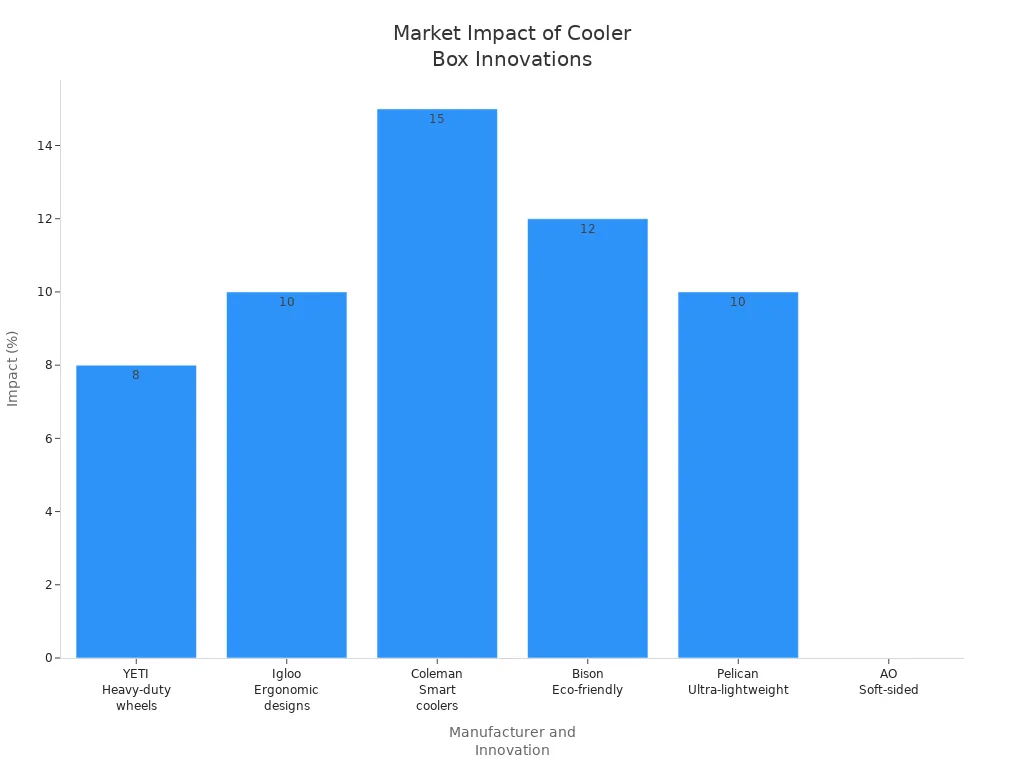
Use these tips to pick the right cooler and get ready for your next adventure.
FAQ
How do you choose the right size cooler box for your trip?
You should count the number of people and days for your adventure. For a weekend trip with four people, a 50-quart cooler works well. For longer trips or bigger groups, pick a cooler with 100 quarts or more.
What is the best way to keep ice from melting quickly in a large cooler?
Pre-chill your cooler before packing. Use large ice blocks instead of small cubes. Keep the cooler in the shade. Open the lid only when needed. These steps help your ice last longer.
Can you use dry ice in a rotomolded cooler?
Yes, you can use dry ice in most rotomolded coolers. Dry ice keeps items frozen for a long time. Always wear gloves when handling dry ice. Make sure your cooler has a vent to release gas safely.
How do you clean and store your cooler after an outdoor trip?
Wash your cooler with warm water and mild soap. Rinse it well and let it air dry with the lid open. Store your cooler in a cool, dry place. This prevents mold and keeps your cooler fresh for your next adventure.

